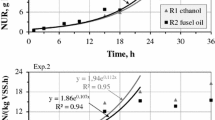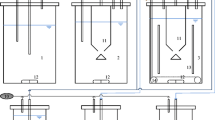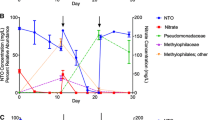Abstract
Samples from an oil storage tank (resident temperature 40 to 60 °C), which experienced unwanted periodic odorous gas emissions, contained up to 2,400/ml of thermophilic, lactate-utilizing, sulfate-reducing bacteria. Significant methane production was also evident. Enrichments on acetate gave sheathed filaments characteristic of the acetotrophic methanogen Methanosaeta thermophila of which the presence was confirmed by determining the PCR-amplified 16S rDNA sequence. 16S rDNA analysis of enrichments, grown on lactate- and sulfate-containing media, indicated the presence of bacteria related to Garciella nitratireducens, Clostridium sp. and Acinetobacter sp. These sulfidogenic enrichments typically produced sulfide to a maximum concentration of 5–7 mM in media containing excess lactate and 10 mM sulfate or thiosulfate. Both the production of sulfide and the consumption of acetate by the enrichment cultures were inhibited by low concentrations of nitrite (0.5–1.0 mM). Hence, addition of nitrite may be an effective way to prevent odorous gas emissions from the storage tank.




Similar content being viewed by others
References
Altschul SF, Gish W, Miller W, Myers EW, Lipman DJ (1990) Basic local alignment search tool. J Mol Microbiol 215:403–410
Boone DR, Whitman WB, Koga Y (2001) Family II. Methanosaetaceae fam. nov. In: Boone DR, Castenholz RW (eds) Bergey’s manual of systematic bacteriology, vol 1, 2nd edn. The archaea and deeply branching and phototrophic bacteria. Springer, Berlin Heidelberg New York, p 289
Cappuccino J, Sherman N (1998) Microbiology: a laboratory manual. Addision Wesley Longman, Don Mills, Ontario, pp 63–67, 311–320, 470
Cato EP, George LW, Finegold SM (1986) Genus Clostridium Prazmowski 1880, 23AL. In: Sneath PH, Mair NS, Sharpe ME, Holt JG (eds) Bergey’s manual of systematic bacteriology, vol. 2. Williams and Wilkins, Baltimore, MD
Cord-Ruwisch R (1985) A quick method for determination of dissolved and precipitated sulfides in cultures of sulfate-reducing bacteria. J Microbiol Methods 4:33–36
Davidova I, Hicks MS, Fedorak PM, Suflita JM (2001) The influence of nitrate on microbial processes in oil industry production waters. J Ind Microbiol 27:80–86
Eckford RE, Fedorak PM (2002) Planktonic nitrate-reducing bacteria and sulfate-reducing bacteria in some western Canadian oil field waters. J Ind Microbiol Biotechnol 29:83–92
Gardner LR, Steward PS (2002) Action of glutaraldehyde and nitrite against sulfate-reducing bacterial biofilms. J Ind Microbiol Biotechnol 29:354–360
Grabowski A, Blanchet D, Jeanthon C (2005) Characterization of long-chain fatty acid-degrading syntrophic associations from a biodegraded oil reservoir. Res Microbiol 156:814–821
Greene EA, Hubert C, Nemati M, Jenneman G, Voordouw G (2003) Nitrite reductase of sulfate-reducing bacteria prevents their inhibition by nitrate-reducing, sulfide-oxidizing bacteria. Environ Microbiol 5:607–617
Head IM, Jones DM, Larter SR (2003) Biological activity in the deep subsurface and the origin of heavy oil. Nature 426:344–352
Hubert C, Nemati M, Jenneman G, Voordouw G (2003) Containment of biogenic sulfide production in continuous up-flow packed-bed bioreactors with nitrate and nitrite. Biotechnol Prog 19:338–345
Kamagata Y, Kawaski H, Oyaizu H, Nukamura K, Mikami E, Endo G, Koga Y, Yamasato K (1992) Characterization of three thermophilic strains of Methanothrix (“Methanosaeta”) thermophila sp. nov. and rejection of Methanothrix (“Methanosaeta”) thermoacetophila. Int J Syst Bacteriol 42:463–468
Klüber HD, Conrad R (1998) Effect of nitrate, nitrite, NO and N2O on methanogenesis and other redox processes in anoxic rice field soil. FEMS Microbiol Ecol 25:331–332
Miranda-Tello E, Fardeau ML, Sepúlveda JL, Fernández L, Cayol JL, Thomas P, Ollivier B (2003) Garciella nitratireducens gen. Nov., an anaerobic, thermophilic, nitrate- and thiosulfate- reducing bacterium isolated from an oilfield separator in the Gulf of Mexico. Int J Syst Evol Microbiol 53:1509–1514
Myhr S, Lillebo B-L-P, Sunde E, Beeder J (2002) Inhibition of microbial H2S production in an oil reservoir model column by nitrate injection. Appl Microbiol Biotechnol 58:400–408
Nadarajah N, Singh A, Ward OP (2002) Evaluation of a mixed bacterial culture for de-emulsification of water-in-petroleum oil emulsions. World J Microbiol Biotechnol 18:435–440
Nemati M, Jenneman GE, Voordouw G (2001) Mechanistic study of microbial control of hydrogen sulfide production in oil reservoirs. Biotechnol Bioeng 74:424–434
Nga DP, Ha DT, Hien LT, Stan-Lotter H (1996) Desulfovibrio vietnamensis sp. nov., a halophilic sulfate-reducing bacterium from Vietnamese oil fields. Anaerobe 2:385–392
Pereira IAC, LeGall J, Xavier AV, Texeira M (2000) Characterization of a heme c nitrite reductase from a non-ammonifying microorganism, Desulfovibrio vulgaris Hildenborough. Biochim Biophys Acta 1481:119–130
Postgate JR (1984) The sulfate-reducing bacteria, 2nd edn. Cambridge University Press, Cambridge
Reinsel MA, Sears JT, Steward PS, McInerney MJ (1996) Control of microbial souring by nitrate, nitrite or glutaraldehyde injection in a sandstone column. J Ind Microbiol 17:128–136
Roberts GAH (1969) Microbiological corrosion of tanks in long-term storage of gas oil. Br Corros J 4:318–321
Snell FD, Snell CT (1949) Colorimetric methods of analysis. D. van Nostrand, New York
Telang AJ, Ebert S, Foght J, Westlake DWS, Jenneman G, Gevertz D, Voordouw G (1997) Effect of nitrate injection on the microbial community in an oil field as monitored by reverse sample genome probing. Appl Environ Microbiol 63:1785–1793
Thorstenson T, Bodtker B, Sunde E, Beeder J (2002) Biocide replacement by nitrate in sea water injection systems. In: Corrosion 2002. Paper 02033. NACE International, Houston, TX
Voordouw G, Niviere V, Ferris FG, Fedorak PM, Westlake DWS (1990) The distribution of hydrogenase genes in Desulfovibrio and their use in identification of species from the oil-field environment. Appl Environ Microbiol 56:3748–3754
Voordouw G, Armstrong SM, Reimer MF, Fouts B, Telang AJ, Shen Y, Gevertz D (1996) Characterization of 16S rRNA genes from oil field microbial communities indicates the presence of a variety of sulfate-reducing, fermentative and sulfide-oxidizing bacteria. Appl Environ Microbiol 62:1623–1629
Watanabe K, Kodama Y, Harayama S, Kaky N (2002a) Diversity, abundance, and activity of archaeal populations in oil-contaminated groundwater accumulated at the bottom of an underground crude oil storage cavity. Appl Environ Microbiol 68:3899–3907
Watanabe K, Kodama Y, Kaku N (2002b) Diversity and abundance of bacteria in an underground oil- storage cavity. BMC Microbiol 2(23):1–10
Widdel F, Bak F (1992) Gram-negative mesophilic sulfate-reducing bacteria. In: Balows A, Truper HG, Dworkins M, Harder W, Schleifer KH (eds) The Prokaryotes, vol 2, 4th edn. Springer, Berlin Heidelberg New York, pp 3352–3378
Wolfe BM, Lui SM, Cowan JA (1993) Desulfoviridin, a multimeric-dissimilator sulfite reductase from Desulfovibriovulgaris (Hildenborough) purification, characterization, kinetics and EPR studies. Eur J Biochem 223:79–89
Zengler K, Richnow HH, Rosselló-Mora R, Michaelis W, Widdel F (1999) Methane formation from long-chain alkanes by anaerobic microorganisms. Nature 401:266–269
Zhou J, Bruns MA, Tiedje JM (1996) DNA recovery from soils of diverse composition. Appl Environ Microbiol 62:316–322
Acknowledgements
This research was supported by a Strategic Grant from the Natural Science and Engineering Research Council of Canada (NSERC) to GV. We thank Dr. Anne Greene for the technical and intellectual assistance.
Author information
Authors and Affiliations
Corresponding author
Rights and permissions
About this article
Cite this article
Kaster, K.M., Voordouw, G. Effect of nitrite on a thermophilic, methanogenic consortium from an oil storage tank. Appl Microbiol Biotechnol 72, 1308–1315 (2006). https://doi.org/10.1007/s00253-006-0412-8
Received:
Revised:
Accepted:
Published:
Issue Date:
DOI: https://doi.org/10.1007/s00253-006-0412-8




